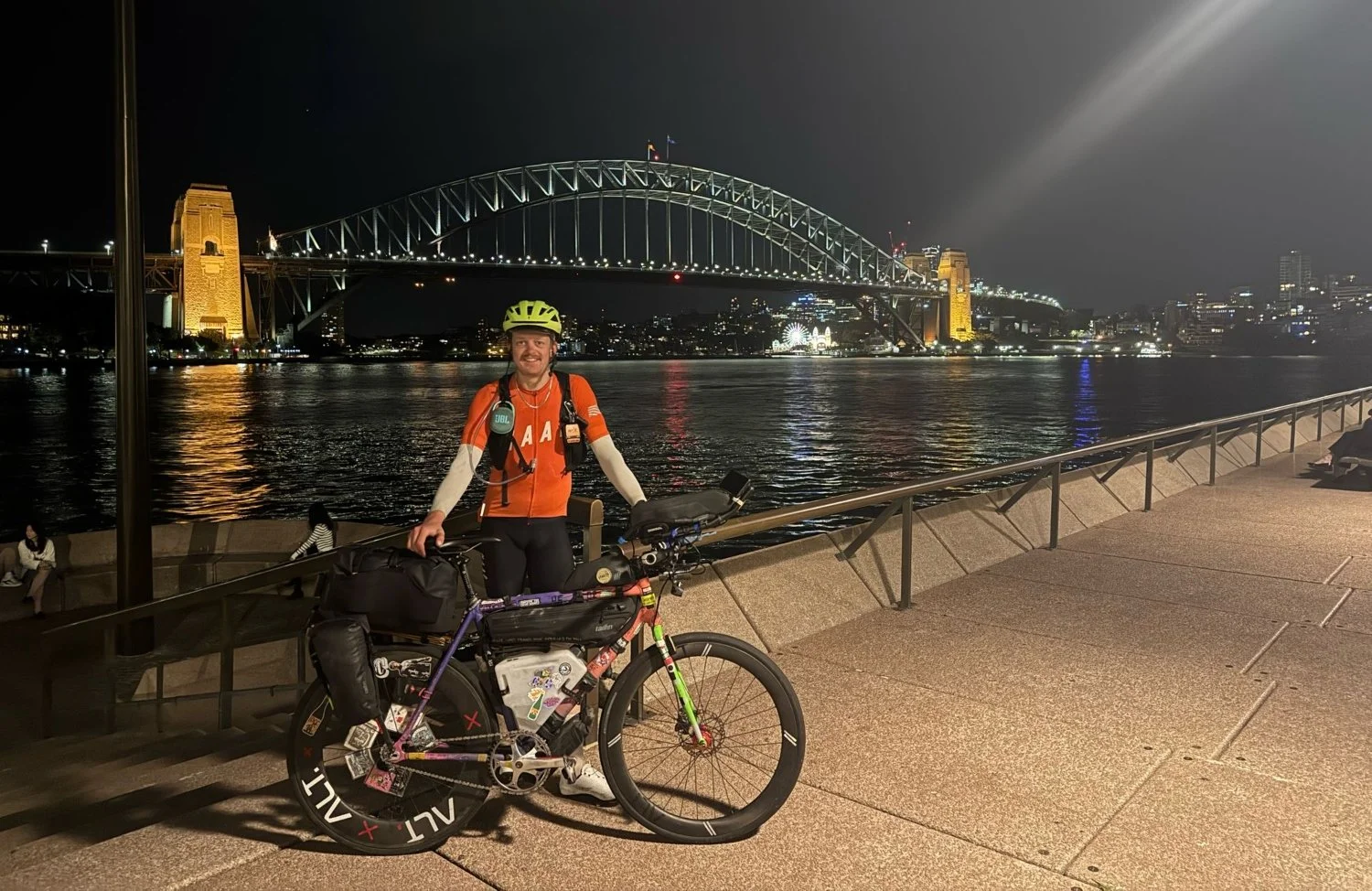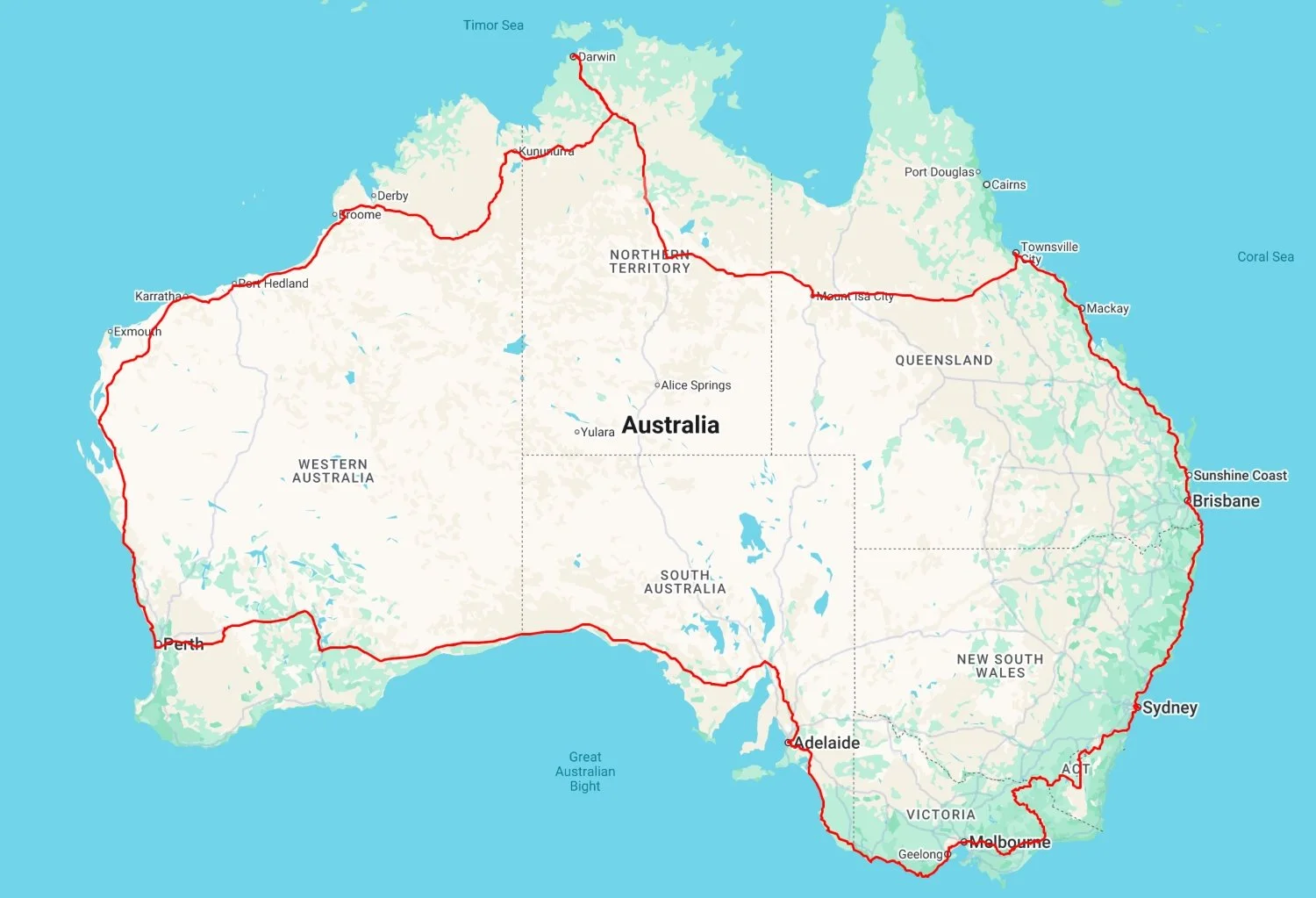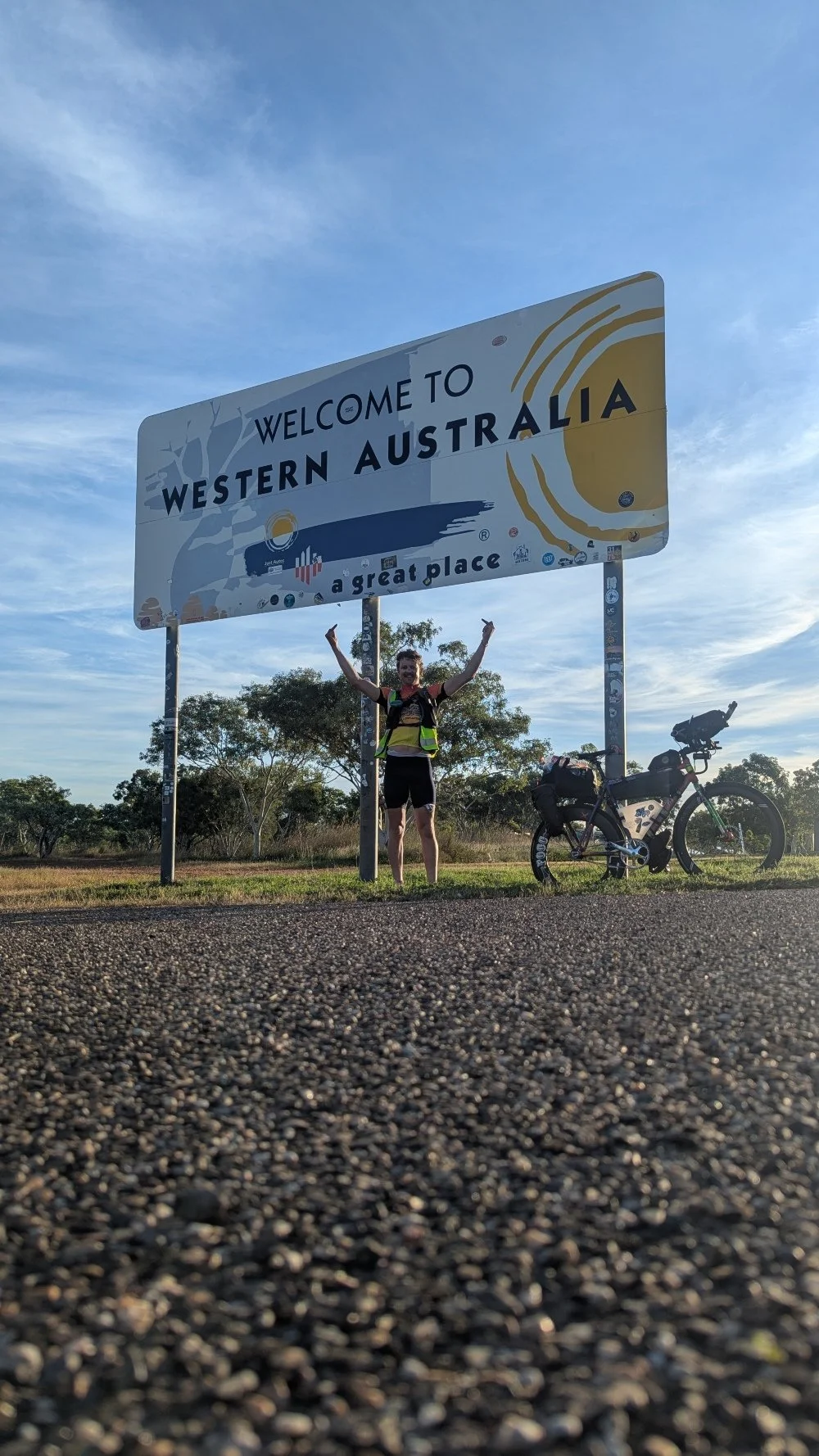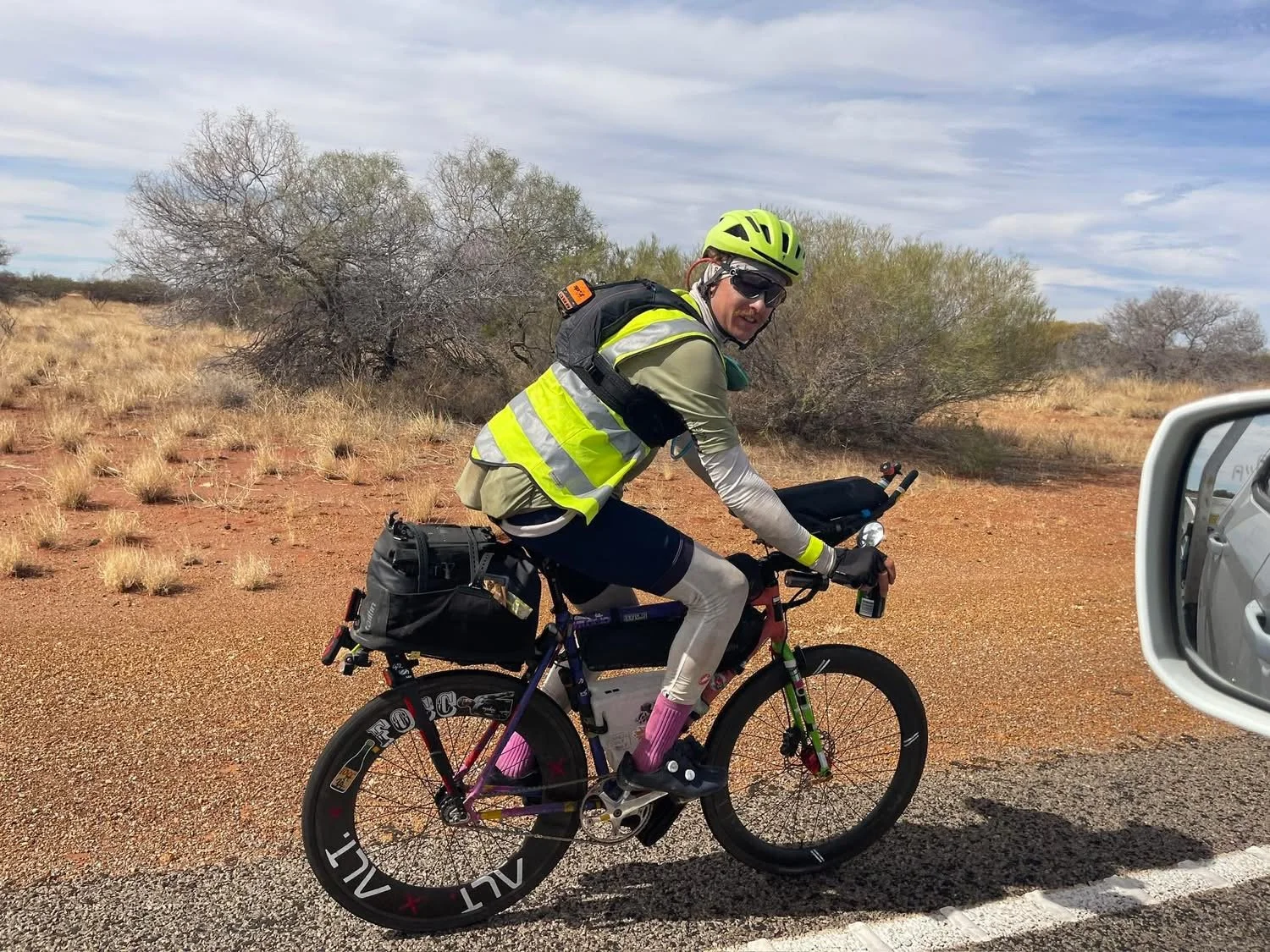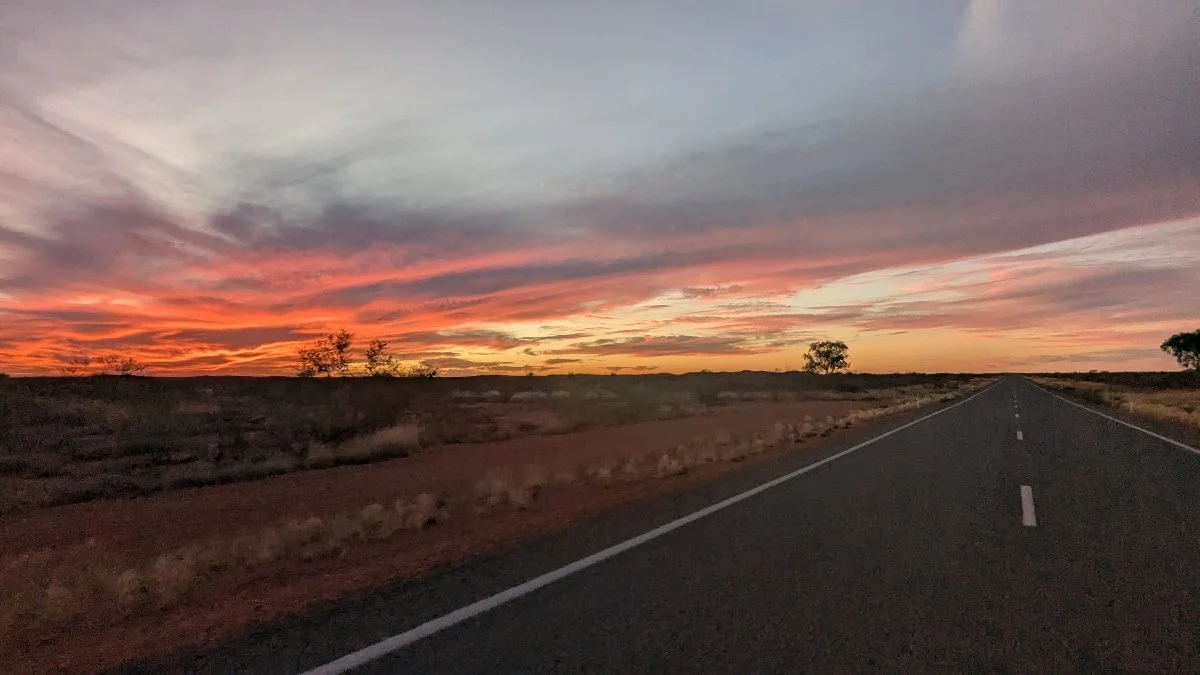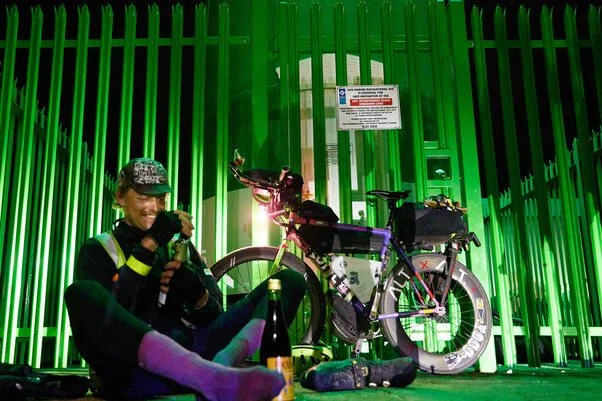The Hot Lap Interview with Lawrence ‘Lozza’ Walters
Interview by Chris Hunt
After more than 50 days solo, riding his bike in one of the hottest and most sparsely populated countries on the planet, Lawrence Walters set a new world record for the fasted unsupported circumnavigation of Australia. In case that wasn’t enough, he did so riding a fixed gear bike. Now, back home in Bristol seeking some sense of normality, Chris catches up with Loz to hear more about the experience.
Some ideas are impossible to shake. For Lawrence ‘Lozza’ Walters, that idea was circumnavigating Australia on a fixed-gear bike. Inspired by Joseph Kendrick’s record breaking fixed lap in 2018, not a week went by when he didn’t give riding his own lap some thought and slowly but surely, he built the experience to make it happen.
In March 2025, Lozza lined up in Freemantle as part of the Indian Pacific Wheel Ride, to begin his journey. After 5,500kms ocean-to-ocean, he arrived in Sydney before pushing on, looping north to Townsville, across the outback to Darwin, and down Western Australia raising funds for the RNLI as he went. Back where he began, having averaged over 300kms per day to cover 14,686km in 50 days, 14 hours and 7 minutes, he broke three world records including: the fastest unsupported lap of Australia by bicycle, the fastest unsupported lap of Australia on a fixed gear, and the furthest distance travelled on a fixed gear bicycle in a month.
So what is it that drives someone to take on such a single-minded goal, what challenges do they face on the road and what does such an effort take from you, both physically and mentally? Several months into his recovery, Chris catches up with Lozza to find out.
What was your gateway to bikes, and how did it evolve through ultras and fixed-gear?
It started riding laps around the house as a teenager. I got into road cycling in my late teens when I was competing in dinghy sailing, needing to stay fit to race nationally and internationally around Europe and the world. The bike was a great tool to get out and see new places at training camps and regattas and ride with friends. Through university the time and money involved to continue sailing became a barrier and the bike took off.
After university, I moved to Bristol for engineering work and began courier work in my spare time. I went full-time delivering fruit and veg through lockdown, racking up 200-300 miles a week on a loaded track bike I had bought for pub runs, but I soon fell in love with it and with so much mileage, the fitness followed. I went on a solo trackpacking tour of the UK at the end of 2020 and was hooked.
Some friends had entered the Pan Celtic Race in 2021 which came through Bristol. Riding with some of the entrants across the suspension bridge I was really inspired and signed up the next year for 2022 around Ireland which would be my first ultra . The rest is history, I guess.
How would you explain the world of fixed gear long distance riding?
Very niche. Very individual. Many people train using fixed gear through winters to build strength and reduce maintenance cost, but not many race fixed gear. But we’re seeing quite a few races with entrants riding single speeds now – Tour Divide, Silk Road Mountain Race – due to simplicity and less risk of mechanical failure.
Riding fixed gear long distance is very introspective. I liken it to riding a horse compared to driving a car, there's something else on the table and its capability needs to be considered alongside the needs and capability of the rider.
So, how did the idea for the hot lap first come about?
In 2018 a courier from London went to Australia to ride the first unofficial Indian Pacific Wheel Ride. Joseph Kendrick finished in Sydney and continued riding up the East Coast to Cairns before flying home to the UK for a couple weeks to sort out a longer visa. He then travelled back to Cairns to finish the rest of the lap back to Perth.
I remember seeing his story after following his YouTube content and was hooked. I knew one day I'd love to ride around Australia, I knew not many would either want to do it or perhaps know how to do a trip of this size. With the knowledge and interest in both of these things I took it as a calling to give it a go!
Why was the fixed-gear element so important?
I never really ever considered doing this ride on a geared bike. Unsupported, the distances are so large the risk of mechanical failure is a lot higher, with limited options for roadside repair. Riding fixed kept it simple. I also find it can be a lot faster for me much of the time, working hard to keep up the momentum of the bike and the cadence high. It pushes me.
Australia is also the flattest continent on the planet. On average around three times less elevation per unit travelled than most of the rides I've done around the South West, Wales, Ireland and Scotland. So it was just a matter of getting over the Victorian Alps and Snowy Mountains. It was certainly flat and fast for the majority, and notoriously windy, particularly in Western Australia. I was inspired to ride another Dolan track bike around the country. It sounded like a cool idea!
14,686 km is such a long distance. Stretched out in a line, it’s enough to cover entire continents – several times in some cases. So why Australia?
The vast nothingness. Overlaying Australia onto Europe it covers most of it and a bit more. The climate appeals to me, the heat, management of resupply, the distances. I was getting to the stage of doing big one day rides in the UK that covered large areas of the country in one or two days, and I was really searching for something bigger. Around the world has never appealed to me, and riding it fixed wouldn't be that fun. Australia ticked a lot of boxes for the fixed gear and it had a calling to me, I had to do it!
It's a simple concept, one goal, you against the clock without much variation in terms of border crossings and you only need one visa. It’s Western culture, there’s no language barrier. It made for a straightforward shift from riding long in the UK to going abroad but it feeling like home in some ways, just over 30 times bigger than the UK with less than half of the population. Crazy!
Before heading out what did you consider the biggest challenges to be?
Long distances between resupply, the heat, finding water.
Did that change at all then when you were riding?
Yeah massively. The distances just meant I had to carry more and took a bit of planning but wasn't too unexpected or variable, you could plan for it and water was easy to find at the expected stops. The real challenge was the traffic, staying safe on the road and managing the passing road trains, mostly three and four trailers long at 60+ metres. Australia's highways are not a place to go and ride a bike. It was expensive too. I camped nearly every night to reduce costs, spending $200-250 a day, I couldn't have afforded to get accommodation as well. I paid for my first two nights of accommodation on day 48 and 49 (of 50) to recover a little before the finish.
I struggled to wake up early in the day to ride from being so exhausted, and ended up riding late each day. I would finish most days between 3-5am, sleep until the sun woke me up and get going again late morning/ lunchtime. It wasn't ideal riding in the hottest part of the day but it's the only way I could get the hours in, many days 14-18 hours worth.
Travelling east, I made a blanket ban of riding 0500-0700hrs, the most dangerous time to be on the road when riding into the rising sun. This is when most of the deaths have occurred, so I chose to not ride around sunrise. I had to be careful heading back west across the north of the country at sunset for the same reason. Being hyper-vigilant around these times, having routines for what to do with passing traffic and being comfortable getting off the road quickly greatly improved my safety.
Covering big distances like this over a long period of time, there are of course endless opportunities to lose time and fall behind, what were your priorities for making sure that didn’t happen?
I didn't think too much about the whole lap and the record really until after Brisbane. It was too big to comprehend. The first stage was giving the IPWR a go, then making progress north up the east coast. After brisbane and certainly by Townsville, which was just over halfway, I could see what the whole lap looked like and started work to claw back time. I was relatively slow in the first half of the trip against the record – averaging 270km a day for the first 27 days – at one point over five days behind record pace. I went with what I felt I could do rather than what the record dictated, knowing that I could hopefully ride into it as the trip went on. I only got onto record pace about three days before the end, riding the second half of the trip at around 330km a day, having to work really hard for the final three-four weeks of the trip to get there.
My priorities in the first half was sleeping as much as I needed to, eating as much as I could and riding the rest, in that order. From leaving the UK in February where it was about 2 degrees it took some time to adjust to the tail end of the Australian summer and I think the first few weeks was just about finding my feet on the road. It was a steep learning curve to get used to a different way of life in the desert.
Towards the end I slept a bit less, rode more, but my body had adjusted considerably and I was able to dish out bigger days having spent weeks of conditioning the body. My biggest seven day period was 380km a day, and the eighth day was 410km. I took the conditions when they allowed me to, and luckily I had incredibly favourable weather which helped a lot. I knew the weather was on my side around the halfway mark and had to make it happen. Things got pretty fast heading into the Northern Territory on the road to Darwin!
Starting out with the Indy Pac then, this must have been an exciting way to start but quite a different mentality to the rest of the effort. How did you find that?
The IPWR has been a long time dream, and I needed the camaraderie of starting with others to learn and share. It was motivating riding as a unit across Australia, not that I really saw anyone after the first day! It was fun getting roped into the race mentality a bit, and broke up the journey. I really enjoyed the comms and knowing people were out there, fighting their own battles while you were battling yours. We all faced 13 days of headwinds out the blocks, and it made this easier knowing we were all in the same boat. It also drummed up some momentum from the dotwatching community when I said I would attempt to ride back to Perth the long way. It was great getting motivational support from the friends I had made on the race to continue.
By the time I got to Sydney I was a couple days behind the plan, losing time in the mountains due to the savage hills in the Victorian Alps and Snowy Mountains. I was really keen to get moving as soon as I arrived and didn't hang about too long, arriving late Friday and on the road again Saturday evening after some rest and food.
It was different to the other four finishers ahead of me who's journeys across Australia finished at the Opera House, but it felt right to get back on the road and I was mentally feeling really ready to continue.
Over long distances, injuries it seems come and go, how was this for you – how did everything hold up?
I didn't really have too much bother, incredibly. I knew there would be a bit of pain and discomfort trying to ride 300km a day, but nothing that was a deal breaker. I had a couple days of knee pain on the approach to Darwin when my bottom bracket started going, but after replacing it, the knee cleared up. That was the first pain I had and that was over 9000kms in. The biggest pain was in my feet. I was trying to sort out issues with hot foot before the IPWR with limited success. I rode most of the lap without insoles to allow some more room in the shoe for my feet to swell. I was using road SPDs to increase the contact area of the foot with the pedal, but I just had to pedal so hard for so long it was pretty painful after about 100kms each day.
I think on the whole, the strength of mind and preparation in the gym helped keep injuries at bay for the most part.
Australia is obviously infamous for its big trucks and road trains, particularly considering what happened to Mike Hall. How did this influence your mindset and strategy going into the ride and also during?
The road train network in Australia is staggering. It has the largest permissible sized loads on any road worldwide at four trailers up to around 60 metres as standard hardware on the highways. These highways are for the most part single carriageways with varying levels of shoulder.
I took the approach of always taking the safer option if there were decisions to be made. This often made decision making quite straightforward, as the decision was made for me. Safety was always number, often at the expense of time or distance, but for peace of mind.
I was very grateful to chat with a number of people who had completed the IPWR before I left for Australia and get some intel on what I could do to improve my safety. The UHF radio was one of the things to come out of these conversations and was so good. I had mirrors on my bars and helmet, Garmin radar and quite often chose to simply get off the road for passing traffic which felt a lot safer. With traffic volumes and temperatures much higher in the day, I ended up riding the majority of the kms at night. The headlights were easy to see, comms on the UHF much better and I could physically push harder in cooler temperatures. Large oversize trucks had escorts front and rear, so I could communicate both to let them know I was aware of the upcoming truck and let them know I was pulling over. It was a great line of comms for both myself and the drivers. At night I would use the radio and light flash signals to alert all drivers of my presence on the road.
I was always content to get off the road if it didn't feel good as I knew full well what the consequences could be.
Things got a bit dicey at times and I reached out to a few people who had completed the lap for advice which really helped settle the nerves about certain sections that I knew were touch and go. Sometimes it just meant waiting until the quieter hours to ride when the road felt safer.
I camped at Mike Hall’s memorial two days before I finished the IPWR with 450 km to get to Sydney. Spending some time at the crash site really allowed me to process what was so real for me on the road in terms of danger. My whole mindset changed after staying there, content that nothing was worth taking the risk of life, and continually tried to learn better habits on the road to make my time safer. Not using my phone, not being too tired, staying alert on the road were all really important factors.
What about your overall bike and kit setup. What do you feel worked well or not so well and is there anything you’d change if you were to go again?
I was pretty nervous for the whole thing and in typical fashion took far too much stuff. I posted stuff back to Perth five times.
Some things that were new for the trip and worked really well were:
A disc brake fork (previously rim brake)
Redshift suspension stem and TT seat post, both really comfy and fast
Tailfin bags, faultless in the extreme conditions
Garmin Radar – essential!
CrankTank – the ability to take four litres in the lower frame triangle
K-lite lights and charging system off the SON dynamo
I could have done with a bigger gear – there were probably five to seven days where I would have used a smaller cog and run a higher ratio. My largest was 49:16, and sometimes it was not enough! I’d also just ditch some of the stuff I posted back such as the tent outer, waterproofs, solar panel, bar bag. Basically everything off the front end of the bike, I posted back the bar bag and the fork mounted bottles after spending 13 days cracking into a headwind!
You were obviously self-supported and on a pretty tight budget too – what was your sleep set up and what was your rhythm for finding places to sleep and how long etc?
Sleep wise I went for a one person Big Agnes tent, Thermarest Neo-Air full length mat, pillow, liner and sleeping bag. Went away with the sleeping bag for the final three weeks as the temperatures were good up North. I realised the trip was going to be expensive after the first few weeks training in Western Australia, so opted to upgrade a few of the camping items to improve sleep quality and reduce the reliance on roadhouses.
I got Wikicamps downloaded offline to find places to sleep each night and generally aimed for something, even if it was a Telstra tower or rest area. Most nights I was finishing between 3-5am and would just try opening doors at the back of roadhouses with good success sometimes to rooms in building sites, laundry rooms to sleep in. Ideally I'd line up a roadhouse for breakfast the next day where distances allowed.
At the start of the trip I was sleeping quite a lot as I feel I needed it and probably wasn't eating enough, probably 5-7 hours a night. As I got a couple weeks in and started eating more I went down to around 4-5 hours a night, and then again to 3-4 hours in the last week trying to get ahead of the record.
Any particularly good or wierd bivvy spots?
Had a pretty epic camp up at the Great Australian bight, plenty of public toilets, a few sports grounds and highway rest areas. I slept in the laundry room at a few roadhouses, found an abandoned motel room that was undergoing refurbishment and let myself in only to get awoken by the builders at 8am!
What do you think the destiny of the record is now, do you hope for someone to challenge it or are you keen to hold onto it for as long as possible?
I'm not precious about keeping it and it wasn’t the focus of the trip when I set out. You only ever borrow records from the previous rider until the next person comes along and you hand it over to them.
I'm confident someone could get around Australia maybe a week faster on a geared bike, Lachlan's supported record is around 30 days and I think 40ish would be achievable. I don't doubt someone could get around faster but I doubt anyone could attempt the trip any safer than I undertook it.
As for the fixed record, I think it could be there a while, it depends who gets inspired!
How has the recovery been – both physically and mentally?
Recovery is taking some time. In the first few weeks I was a mess. Huge mood swings, incredible levels of fatigue. I'm focusing on building testosterone back up in the gym and came off caffeine for five weeks recently to reset after a lot of abuse during the ride.
Mentally I'm feeling a lot better and working on rebuilding my life again after pouring everything into this trip. It took so much from me and I’m happy to be investing in other areas of my life right now outside of cycling. The box of matches has truely been burnt!
And what does normal life look like for you now – are there any big changes since the ride?
Normal life before was working as a Naval Architect, I'm working towards getting a job again in that space and back to a routine. Since coming back, I moved in with my girlfriend in Bristol which has been epic, realising the comfort of home is all I was seeking when I was out on the road. I needed to go away and take that break to realise what I had was all I needed.
Are you thinking about what might be next on the bike?
I'm still not super gassed about doing big miles, I think the box of matches has been lit and the fires out right now. But other sports have been exciting for me and training in the gym to get some strength in body and mind. I'd love to step away from the intensity of racing and return to where it started for me with touring and enjoying epic places to travel. Definitely done with the tarmac for a bit so it's big tyres and rough trails when I’ve been back on the bike.

